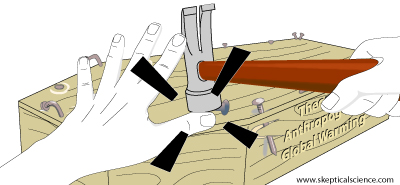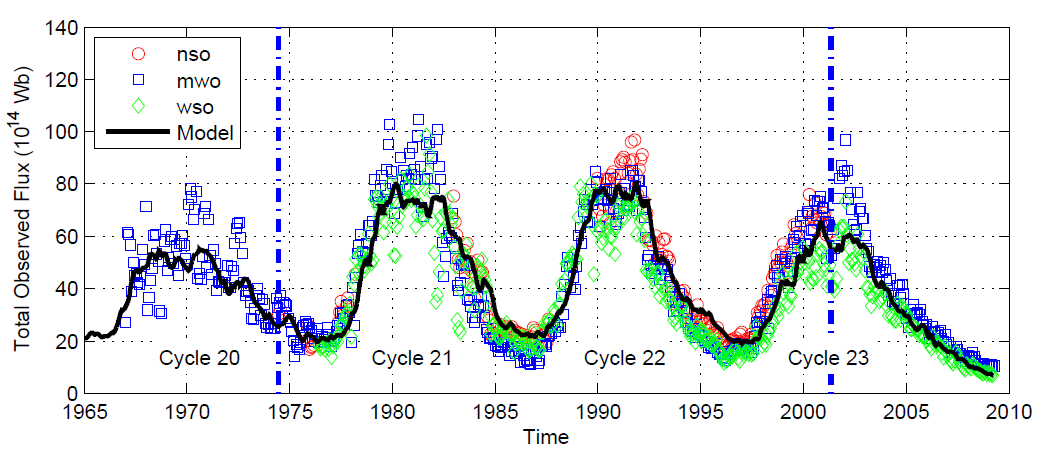CERN - Saying Nothing About Cosmic Ray Effects on Climate
Posted on 13 September 2011 by dana1981
CERN scientist Jasper Kirkby, about his recent cosmic ray experiment:
"At the moment, it actually says nothing about a possible cosmic-ray effect on clouds and climate, but it's a very important first step"
At CERN, Europe's high-energy physics laboratory near Geneva, Switzerland, scientists created an experiment to test how clouds are formed. The experiment ties in with a climate "skeptic" hypothesis that cosmic rays (charged particles from space) are causing global warming. As the hypothesis goes:
Solar magnetic field gets stronger => More cosmic rays are blocked from reaching Earth => Clouds, which are hypothetically seeded by cosmic rays, are less likely to form => Fewer clouds means more sunlight reaches Earth's surface => More sunlight means warmer temperatures => global warming!
Many climate "skeptic" bloggers and commenters have claimed that the CERN experiment has proven that cosmic rays are causing global warming, and that the experiment is "the final nail in the man-made global warming coffin" (i.e. here and here and here and here). It's always the final nail in the coffin, isn't it?

In reality, the CERN experiment only tests the bolded step in this list of requirements for cosmic rays to be causing global warming:
- Solar magnetic field must be getting stronger
- The number of cosmic rays reaching Earth must be dropping
- Cosmic rays must successfully seed clouds, which requires:
- Cosmic rays must trigger aerosol (liquid droplet) formation
- These newly-formed aerosols must grow sufficiently through condensation to form cloud-condensation nuclei (CCN)
- The CCN must lead to increased cloud formation
- Cloud cover on Earth must be declining
In short, the CERN experiment only tested one-third of one out of four requirements to blame global warming on cosmic rays. Whoops, not quite a nail in the coffin!

Additionally scientists have measured solar activity and the number of cosmic rays reaching Earth, and neither meets the first two requirements listed above. Both solar magentic field strength and the number of cosmic rays reaching Earth have been flat over the past 50+ years (Figure 1).
Figure 1: Solar Magnetic Field Strength from 1967 to 2009 (Vieira and Solanki 2010)
A number of other recent studies have also found that cosmic rays have minimal influence on cloud formation, and thus minimal influence on global warming.
As Dr. Kirkby said in the quote above, it is an important first step, just like buying eggs is an important first step in baking a soufflé. But just having some eggs doesn't mean I can bake a successful soufflé. There are a whole lot of other requirements necessary for me to bake a soufflé, and believe me, I don't meet them!
As is always the case, this climate "skeptic" declaration about "the final nail in the coffin" is no such thing. Not even remotely close. Every time they declare the man-made global warming theory dead, it comes back to life.

Note: Graphics provided by SkS user jg. This is the Basic rebuttal to CERN CLOUD experiment proved cosmic rays are causing global warming. Thingsbreak's CERN post has been adapted into the Intermediate version. The rebuttal can also be found at te short URL http://sks.to/cern.































 Arguments
Arguments































[DB] Your 2nd linked graphic has no URL. It is considered good form to give a source (and a link where it exists) to outside sources used. Example:
Your first graphic is from:
http://www.appinsys.com/GlobalWarming/GW_Part6_SolarEvidence_files/image023.gif
And the last is from:
http://www.appinsys.com/GlobalWarming/GW_Part6_SolarEvidence_files/image024.gif
BTW, appinsys.com is well-known to be a disinformationist site. Original sources are best.
[DB] "The observed warming isn't happening anymore."
Now you are simply trolling. Perhaps you missed the announcements about 2010 being the hottest year on record?
"It was the sun, which we cannot control."
Waaay off-topic and very wrong as well. Debunked and rebunked. Use the Search function to find the "It's the Sun" thread for a more appropriate thread for this discussion.
Please note that this is a science-based discussion forum. As such, unsubstantiated opinions, like those in your comment above, are given little credence.
[DB] Please take the discussion of contrails to a more appropriate thread, like CO2 is not the only driver of climate.
[DB] Besides the obvious cherry-picking, using information derived from a known disinformationist website (appinsys) tremendously undermines your credibility here.
[DB] Alright, no more off-topic comments (and this applies to everyone). If anyone wishes to pursue any of this further, please take it to the appropriate thread. This thread is about CERN - Saying Nothing About Cosmic Ray Effects on Climate.
tblakeslee, part and parcel of adherence to the Comments Policy of this website is staying on-topic to the OP of the thread you are posting on. Nearly 5,000 other threads exist here at SkS on virtually anything related to climate science. Please use the Search function to find the most appropriate thread for comments not pertaining to this thread.
[DB] "I realized that it was possible that the IPCC had made a mistake."
Certainly "possible", but do not conflate "possible" with "probable". In a many-thousands-of-pages document, errors can creep in. Typo's and some minor errata in WG2 and WG3, yes. But the core of the science of climate change found in WG1 is unchanged and really not scientifically contested. A long, but good, read. I recommend it.
"The responses I received were mostly "straw man" arguments about mistatements of my position and ad homium attacks on my sources."
Please give examples to them. Failing that, this is an unsupported and unsubstantiated attack on the other participants here and you will need to withdraw that attack with the requisite words of apology.
"It appears that this blog is not about discussion to discover the truth but rather about promoting a dogma."
IBID.
"I was hoping you would change my mind but instead you have shown that this is a religion and you are defending the faith."
Since you have no scientific position and basis to rely upon you fall back upon the usual rhetoric of those with a paucity of factual substance for their platform and the prosecution of their agenda. Very disappointing and unoriginal.
Please note that posting comments here at SkS is a privilege, not a right. This privilege can and will be rescinded if the posting individual continues to treat adherence to the Comments Policy as optional, rather than the mandatory condition of participating in this online forum.
Moderating this site is a tiresome chore, particularly when commentators repeatedly submit offensive or off-topic posts (yes, you are still off-topic). We really appreciate people's cooperation in abiding by the Comments Policy, which is largely responsible for the quality of this site.
Finally, please understand that moderation policies are not open for discussion. If you find yourself incapable of abiding by these common set of rules that everyone else observes, then a change of venues is in the offing.
Please take the time to review the policy and ensure future comments are in full compliance with it. Thanks for your understanding and compliance in this matter.